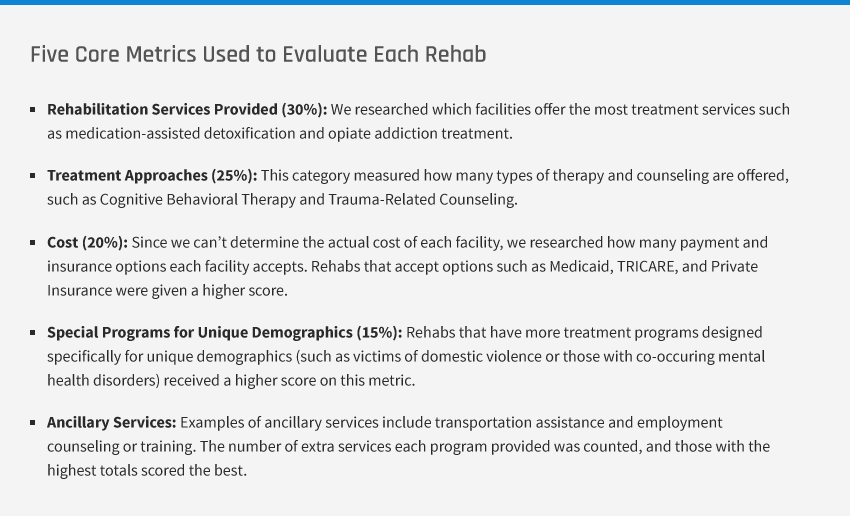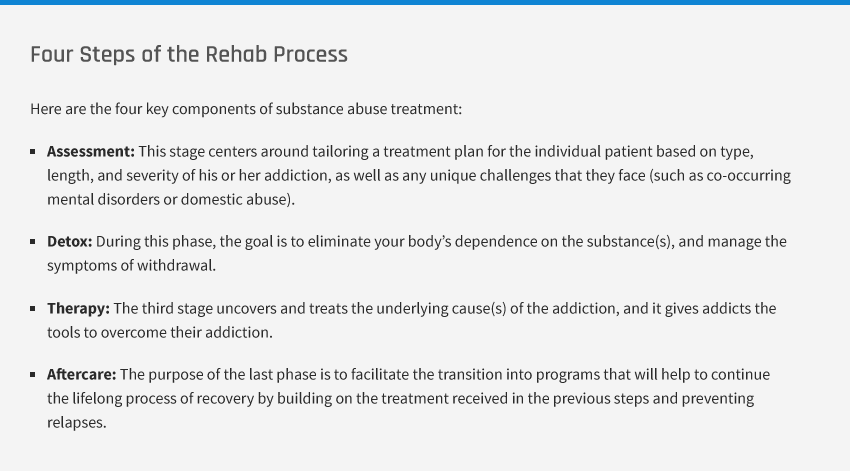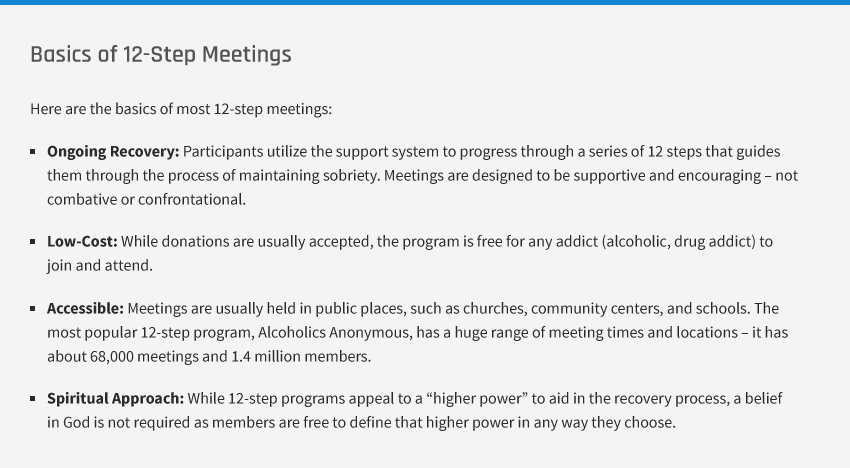Veterans face unique challenges that can put them at higher risk for substance abuse than the general population. Factors leading to increased risk include things like PTSD and homelessness.
Alcohol, Drug, and other Rehab Centers in Chicago, IL
TABLE OF CONTENTS
Getting Help
What to Consider When Choosing a Rehab Center
There are many different types of rehab programs and treatment options to consider. Here are a few of the decisions you need to make:
- Service Setting: Will you be considering residential inpatient programs or outpatient programs?
- Specialized Rehabs: Are you interested in holistic rehabs or rehabs for dual diagnosis, or just alcohol and drug detox?
- Rehab Lengths: Are you looking for a shorter rehab length (30 days) or a longer-term option (60, 90, or 120+ days)?
The main factors that determine which rehab options will be best for you are the severity of your addiction and your unique personal and financial situation.
For more information on how to make all of these decisions, read our guide to Choosing the Right Rehab
The Best Rehabs in Chicago, IL
If the cost of rehab is a barrier for you (as it is for many) and you don’t have insurance, there are still ways for you to get help. There are 585 rehab facilities recognized by the Substance Abuse and Mental Health Administration (SAMHSA) in Illinois, and 94 of those offer some sort of payment assistance to most adults. Out of those 94, over half are located in Chicagoland, with the Elmhurst Campus of Behavioral Services Center receiving the highest overall score in the state from Help.org.

For more information about the five core metrics, head to the full breakdown of our filtering process and ranking methodology
1. Behavioral Services Center - Elmhurst Campus
The Elmhurst Campus of Behavioral Services Center offers group classes, outpatient, and intensive outpatient treatment services and is located near the O’Hare International Airport in Chicago. The rehab received an overall score of 9.2, and it’s highest score was on the metric that measured rehab services provided. It provides 13 different rehab services, which was the highest total of all the rehabs we researched.
The rehab’s weakest performance came on “Cost” – it was given a score of 7.7, which is still considerably above average. The main factor that kept the facility from scoring higher was the fact that it doesn’t offer any other type of payment assistance besides sliding scale fees.
- Rehabilitation Services Provided: 10
- Treatment Approaches: 10
- Cost: 7.7
- Special Programs for Unique Demographics: 8.3
- Ancillary Services: 9.5
2. Behavioral Services Center - Skokie Campus
While the Skokie Campus of Behavioral Health Services is run by the same company that runs the Elmhurst Campus, the Skokie Campus received slightly lower scores in “Cost” and “Special Programs for Unique Demographics.” The Skokie Campus offers two less special programs for unique demographics than Elmhurst does. However, it does provide two more ancillary services than the Elmhurst Campus, giving it a perfect score in that category, while Elmhurst received a 9.5.
Like the Elmhurst Campus, the Skokie Campus of Behavioral Health Services exclusively provides several types of outpatient treatments.
- Rehabilitation Services Provided: 10
- Treatment Approaches: 10
- Cost: 6.6
- Special Programs for Unique Demographics: 8.3
- Ancillary Services: 10
3. Behavioral Services Center - Chicago Loop Campus
Like the Skokie and Elmhurst Campuses, the Chicago Loop Campus is run by Behavioral Services Center and provides outpatient, intensive outpatient, and individual therapy sessions to the greater Chicago area.
The programs designed for unique demographics that the rehab offers is the program’s biggest drawback, followed closely by its performance on the “Cost” core metric. On the other hand, the facility was given perfect scores on “Rehabilitation Services Provided” and “Treatment Approaches.”
- Rehabilitation Services Provided: 10
- Treatment Approaches: 10
- Cost: 6.6
- Special Programs for Unique Demographics: 6.4
- Ancillary Services: 9.5
Top-Rated, Low-Cost Treatment Centers in Illinois
| Rank | Rehab | Total Score | Contact Information |
| #1 | Behavioral Services Center – Elmhurst Campus | 9.2 | 188 Industrial Drive Suite 100 Elmhurst, IL 60126 Main Tel: 847-929-4068 Intake Tel 1: 847-673-8577 |
| #2 | Behavior Services Center – Skokie Campus | 9.1 | 8707 Skokie Boulevard Suite 207 Skokie, IL 60077 Main Tel: 847-673-8577 Intake Tel 1: 847-929-4068 |
| #3 | Behavioral Services Center – Chicago Loop Campus | 8.8 | 161 North Clark Street Suite 1600 Chicago, IL 60602 Main Tel: 847-673-8577 Intake Tel 1: 847-929-4068 |
| #4 | Behavioral Services Center – Mundelein Campus | 8.5 | 25975 Diamond Lane Road Suite 111 Mundelein, IL 60060 Main Tel: 847-929-4068 Intake Tel 1: 847-673-8577 |
| #5 | Behavioral Services Center – Gurnee Campus | 7.4 | 5101 Washington Road Suite 1114 Gurnee, IL 60031 Main Tel: 847-673-8577 |
| #6 | ABRAXAS Youth and Family Services Southwood Interventions | 6.9 | 5701 South Wood Street Chicago, IL 60636 Main Tel: 773-737-4600 |
| #7 | Leyden Family Service SHARE Program |
6.5 | 1776 Moon Lake Boulevard Hoffman Estates, IL 60169 Main Tel: 847-882-4181 Intake Tel 1: 847-843-4949 |
| #8 | Gateway Foundation Alcohol and Drug Treatment/Lake Villa | 6.1 | 25480 West Cedar Crest Lane Lake Villa, IL 60046 Main Tel: 847-356-8205 x3366 Intake Tel 1: 847-356-8205 |
| #9 | Trilogy Inc | 5.7 | 1400 West Greenleaf Avenue Chicago, IL 60626 Main Tel: 773-508-6100 Intake Tel 1: 773-508-6100 x4060 |
| #10 | Lake County Substance Abuse Program | 5.5 | 3004 Grand Avenue Waukegan, IL 60085 Main Tel: 847-377-8120 |
Finding a Substance Abuse Treatment Center in Chicago
Start by determining your coverage
If you have private insurance or coverage purchased through the healthcare marketplace, contact your plan provider to determine exactly what services are covered. If you have Medicaid (or to determine whether you qualify), visit illinois.gov to get started. Whatever type of coverage you have, insurance companies (public and private) are required to cover substance abuse treatment for qualified individuals.
Use our database to find a treatment center near you
The tool below lists all of the treatment centers in the state of Illinois recognized by the Substance Abuse and Mental Health Services Administration (SAMHSA). Input your zip code and select the filter icon to find relevant rehabs near you.
Schedule an assessment
If you are pursuing treatment that will be covered by insurance, your first step will be scheduling an assessment with a qualified individual such as a therapist or counselor. Most facilities provide assessments, or your primary care provider may be able to refer you. Contact companies in our database above to find out if they will provide this service.
Find a Rehabilitation Facility Near You
Filter Your Search
Popular Searches
Type Of Care
Treatment Approaches
Service Setting
Age Groups Accepted
Ancillary Services
Facility Operation
Facility Smoking Policy
Gender Accepted
Language Services
License Certification Accreditation
Payment Assistance Available
Payment Methods and Insurance Accepted
Special Programs Groups Offered
What to Expect in Rehab
There are many different methods for treating addiction, and the science of studying addiction is constantly improving and changing. However, the core pieces of treatment are generally the same.

For more on what to expect in rehab, read our guide on the addiction rehabilitation process
Rehab for At-Risk Groups
Substance Abuse Treatment for Veterans
1 in 15 veterans had a substance use disorder in 2015
1 in 15
Veterans had substance use disorder in 2015
Thankfully, Veterans have access to additional resources for treatment, and VA benefits often cover the cost. To get help with substance abuse from the VA health care system follow these steps:
- Enroll: If you aren’t enrolled already, you can check to see if you are eligible by using the Health Benefits Explorer, and then complete the application.
- Discover: Find out whether your local VA center provides substance use disorder (SUD) treatment by calling or visiting the center. If you don’t know where the closest VA is, call the VA hotline to find out: 1-800-827-1000.
- Find Treatment: If your local VA does provide SUD treatment, then discover what your options are and enroll in treatment. If your local VA doesn’t provide SUD treatment, then use the SUD program locator to find one that does.
You can also use the appropriate filter in our database above to find veteran-specific treatment options.
For more information, read our guide on Substance Abuse Rehab for Veterans
Substance Abuse Treatment for Teens
The challenges for youth are usually different than those facing adults, and not all treatment centers offer special programs. Use our treatment finder and the appropriate filter to find those that do. As with adults, payment assistance and other financial help are available at the state-funded treatment centers which you can identify using our “low-cost” filter.
Co-Occurring Mental Health & Substance Abuse Treatment
Substance abuse and mental health issues tend to go hand-in-hand – the technical term is “co-occurring mental and substance use disorders.” Based on data from The Substance Abuse and Mental Health Services Administration (SAMHSA), 18% of those with some form of mental health illness also have a substance use disorder, and 41% of those with a substance use disorder also have a mental health disorder.
Mental Health Resources & Treatment
If you or someone you love is suffering from mental health issues such as depression, PTSD, eating disorders, or severe anxiety, there are many resources and ways to get help.
If you feel that you or a loved one is in a crisis, here are a few quick ways that MentalHealth.gov recommends to get immediate help:
- Emergency Services: If your life (or someone else’s life) is in danger, always start by dialing 911 to get immediate access to emergency services.
- Suicide Prevention: The number for the National Suicide Prevention Lifeline is: 800-273-8255. You can also initiate a private live online chat.
- Veterans Crisis Line: Dial 800-273-8255 to talk to someone immediately. You can also access help with a private online chat, or you can text 838255.
Those who have mental health issues and a substance abuse problem may benefit from dual-diagnosis rehabs. Use the appropriate filter in our tool above to find rehab centers with programs designed to meet the unique challenge posed by co-occurring disorders.
Finding Aftercare in Chicago
Aftercare is one of the often overlooked yet crucial steps in the rehabilitation process. The chances of relapsing from drugs after rehab dramatically rise for individuals who just try and go back to “normal life,” rather than pursuing further treatment in aftercare. There are several types of aftercare including follow-up visits for continued therapy, group therapy, and sober living homes.
Alcoholics Anonymous designed the 12-step process for recovering from an alcohol addiction. Today there are many other 12-step programs for other addictions and issues, including Narcotics Anonymous for those struggling with drug addictions.

Contact the appropriate local organization to find an AA or NA meeting near you
The tool below lists the contact information for local organizations that will connect you to Alcoholics Anonymous (AA) or Narcotics Anonymous (NA) meetings near you. Since meeting times and locations change periodically, contact the local groups that coordinate the meetings to ensure that the information is up to date.
Alcoholics Anonymous (AA) and Narcotics Anonymous (NA) Database
| Name | City | Program | Telephone | Spanish Hotline |
|---|
Sober Living Homes
Sober living homes (also referred to as recovery residences) are group homes that help recovering addicts transition from treatment facilities to living on their own, while maintaining sobriety. They are especially helpful for those who don’t have a supportive and positive environment to live in after rehab.
Residents can stay for a couple months of for years, as long as they follow the rules and don’t relapse (most homes have a zero tolerance policy for using substances). Other rules usually include completing chores, attending mutual support groups regularly, and paying an equal share of the cost of renting the home.
Some halfway houses are listed in our database, and you can find them by using the appropriate filter in our tool above. Otherwise, head to our guide on sober living homes to learn more about sober living homes, and to find a certified recovery residence near you.
Substance Abuse in Chicago
Overview
Heroin is a serious concern in Chicago, and it’s getting worse
35%
of 2015 rehab admissions in Chicago were for heroin
16%
of 2015 rehab admissions in the US were for heroin
A 2015 study by the Illinois Drug Policy Consortium indicates that the percentage of treatment admissions in the Chicago Metroplex for heroin in 2012 was more than double the national average (35.1% vs. 16.4%), and 18.6% of arrestees tested positive for opiates (including heroin) which is the highest rate in the nation.
In addition to the statistic above, there are numerous statistics that indicate that the heroin usage is a much bigger problem in Chicago than it is nationally, and it’s getting worse over the last few decades. For instance:
- In 2015 there were 355 deaths resulting from cocaine overdoses in Cook County – that’s 23 more deaths than there were in 2014 and 64 more deaths than in 2013.
- The same study by the Illinois Drug Policy Consortium also related that publicly funded treatment for heroin was only 4% of the total treatment in 2007, but by 2012 it more than quadrupled to 18%.
Compared to the U.S., the prevalence of substance abuse in Chicago is about average
According to data collected by the Substance Abuse and Mental Health Authority (SAMHSA), 1.1 million people over the age of 12 use illegal drugs yearly in Chicagoland – that works out to 14.8% of the population which is nearly equal to the national percentage of 14.7%. However, the annual average for past-year binge drinking is higher than the national average (26.5% vs. 23.2%)
The number of deaths in Chicago from substance abuse is comparatively low
9%
of Chicago deaths are caused by drugs and alcohol
13%
of US deaths are caused by drugs and alcohol
According to the Centers For Disease Control (CDC), the national percentage of deaths caused by drugs and alcohol is 13.36% – Chicago’s percentage is quite a bit lower at 8.9%. Additionally, the percentage of youth who die because of drugs or alcohol is low at only 2.47% (compared to 5.3% nationally).
Drug and Alcohol Induced Deaths in Cook County Between 2006 and 2015
| Ages: 12-17 | Ages: 18+ | All Ages | |
| Drug-Induced Deaths | 27 | 32,325 | 32,371 |
| Alcohol-Induced Deaths | N/A | 6,437 | 6,445 |
| Total Deaths | 1,418 | 428,492 | 436,462 |
| Percentage of Drug & Alcohol Induced Deaths | 2.47% | 9.05% | 8.90% |
Source: CDC WONDER
Key Indicators of Substance Abuse Issues
When trying to understand the substance abuse problem in a specific area, researchers and policy makers examine “key indicators.” Combined with usage stats, key indicators can provide a deep level of insight into which substances and demographics present the biggest problem and are at the highest risk. Below, the key indicators that have recent, credible statistics available are examined.
Homelessness in Chicago is decreasing
A high rate of homelessness in an area indicates a greater potential for substance abuse problems. Homelessness has been shown to be linked to substance abuse as both the cause and result – sometimes substance abuse is the reason for homelessness, and other times homelessness contributes to it.
While the relative number of homeless people in Chicago is much higher than the national average, the number has recently been improving. On a single night in 2016, there were 5,889 homeless people (sheltered and unsheltered) which is a 23% decrease from 2015 and the lowest count in over 10 years.
Below you can see homelessness trends in Chicago and the U.S. over the last six years. The data is expressed as the number of homeless people per 10,000 population. In 2016 there were 21.8 homeless people in Chicago and 17 across the U.S. (per 10,000 population).
Suicides rates in Chicago are relatively low
Suicide rates help to indicate the severity of the mental health issues in Chicago. An estimated 39% of all those with a substance use disorder also have mental health problems. The data may suggest that fewer residents of Chicago struggle with mental health issues, that treatment is more readily available, or that the severity of the mental health problems is overall less severe compared to other parts of the country.
The graph below shows the suicide rate per 100,000 people in Cook County between 2006 and 2015 compared to the overall rate in the United States.
Take Action
Substance abuse treatment is available for anyone who needs help in Chicago – you don’t have to struggle alone. To get help, determine your insurance coverage, then use our tool to find and contact a rehab center near you to schedule an assessment. Remember, many low-cost rehab centers can help if you don’t have insurance coverage or feel that rehab is out of the question due to financial constraints.


